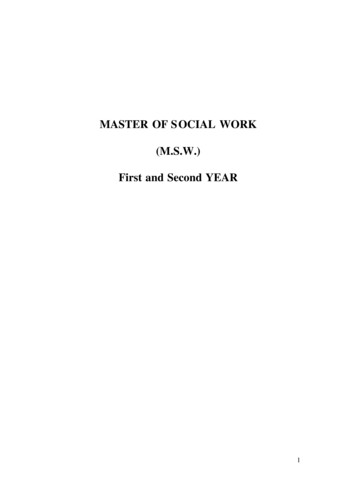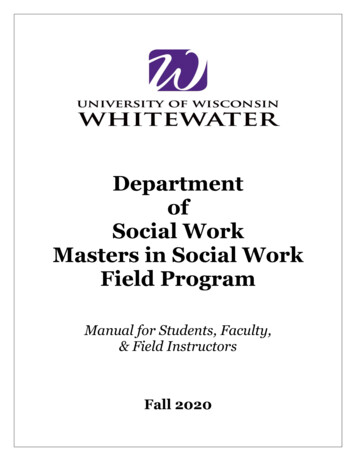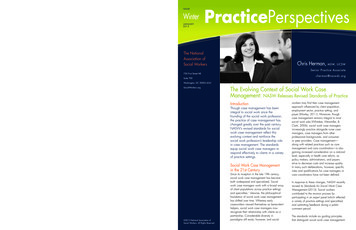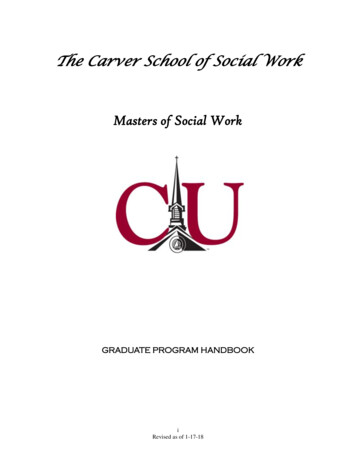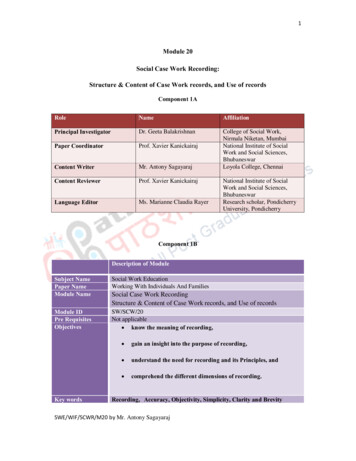
Transcription
1Module 20Social Case Work Recording:Structure & Content of Case Work records, and Use of recordsComponent 1ARoleNameAffiliationPrincipal InvestigatorDr. Geeta BalakrishnanPaper CoordinatorProf. Xavier KanickairajContent WriterMr. Antony SagayarajCollege of Social Work,Nirmala Niketan, MumbaiNational Institute of SocialWork and Social Sciences,BhubaneswarLoyola College, ChennaiContent ReviewerProf. Xavier KanickairajLanguage EditorMs. Marianne Claudia RayerNational Institute of SocialWork and Social Sciences,BhubaneswarResearch scholar, PondicherryUniversity, PondicherryComponent 1BDescription of ModuleSubject NamePaper NameModule NameSocial Work EducationWorking With Individuals And FamiliesModule IDPre RequisitesObjectivesSW/SCW/20Not applicable· know the meaning of recording,Key wordsSocial Case Work RecordingStructure & Content of Case Work records, and Use of records·gain an insight into the purpose of recording,·understand the need for recording and its Principles, and·comprehend the different dimensions of recording.Recording, Accuracy, Objectivity, Simplicity, Clarity and BrevitySWE/WIF/SCWR/M20 by Mr. Antony Sagayaraj
2Quadrant 1IntroductionIn social casework practice, recording is defined as the process of writing down relevant informationin a systematic manner about the person who has come to the agency seeking some help. Theinformation is about the person, his or her problem, the social, economic, and health factorscontributing to the situation of the person, the prognosis, the type of intervention, the progress of theintervention, and the procedures for termination or referral.Social casework practice involves many types of recording depending upon factors such asrequirements of the agency, the theoretical perspective of the caseworker, the type of intervention, andso on.Objectives·To know the meaning of recording,·To gain an insight into the purpose of recording,·To understand the need for recording and its Principles, and·To comprehend the different dimensions of recording.Recording is a written summary of the process of casework. The records of individuals are legallyprotected, except under special circumstances. Records allow case workers an opportunity todocument their work with individuals and afford legal protection against suits, as they can show thatcaseworkers had followed an intervention plan based on an appropriate assessment. Recording isimportant as it publicizes the efficiency of the services. Facts have to be gathered, organized, andrecorded for measurement of results. In the process of giving assistance to an individual there is also aneed to record and document the proceedings for further follow-up and cross verification.Need for recordingThere are compelling reasons to keep good records. Recording is an important and integral part of thecase work procedure and is an output of the activity of the case work. The importance of recordinglies in both the process as well as the product. As recording and documentation is part of everyprofession , case work recording is an inevitable part of the case work process. The demands ofSWE/WIF/SCWR/M20 by Mr. Antony Sagayaraj
3recording go along with the pressing demands of accountability and documentation in anyprofession.Principles of RecordingThere are some guiding principles for maintaining a good record. However there is no such thing asan ideal or model record. A record is a flexible instrument, which should be adapted to the needs ofthe case. Each case is different, the conditions of work have marked differences and the recordingtherefore rests not on following an outline, but in the mastery of certain component processes.o Accuracy, objectivity, simplicity, clarity and brevity should be observed in writingrecords.o Facts and their interpretation should be distinguished between, as that leads to realobjectivity of the subject matter. The outcome should be drawn in a balancedmanner without attempting to influence the judgment of the reader. For example,frequent fights between the husband and wife might lead the case worker tointerpret that the wife dislikes or hates her husband.o The record must be orderly in its arrangement. The caseworker should think inadvance what should be included and then set the material out in a logicalsequence.o The case work records are not meant to be literary masterpieces, therefore theyshould be written in simple language and simple style.o A verbatim quote can sometimes depict a situation much better than a narrativedescription. Therefore, wherever possible, the reactions of the individuals should berecorded in their own words.o There should be a certain degree of uniformity and standardization as to the form ofobservation.o A record should have readability and visibility and should contain a clear and concisepresentation of the material. For example, content can be organised under topicalheadings such as interviews, home visits, and contact contacts.o To maintain clarity and accuracy, avoid using words that are ambiguous.o Note-taking, as far as possible, should be done immediately at the end of theinterview and not during the interview.o It should always be made clear who are involved in the situation, who is addressingwhom and what the sources of information are.o The details of every significant subject or situation should be given.SWE/WIF/SCWR/M20 by Mr. Antony Sagayaraj
4o One should not record the self-evident, the insignificant, the familiar, and therepetitive.o Any record should show clearly the nature of the problem presented or therequest made.Key Purposes of Recording·Recording helps in effective assessment and intervention of the person withproblem.·It enables more effective interviewing and intervention in the case work process.·It helps to contribute to analytical reflection and improvement in case workpractice.·It is useful for organising and structuring of information and for orderly thinking.·It refreshes the memory of the worker and increases retrospective understanding.·It enables better planning for subsequent interviews.·It ensures continuity if any case worker discontinues the process or comes for thenext session after a long time.·It helps in measuring or assessing the ability of the agency.·It helps for future reference of the person with the problem.·It helps in supervision and training of students in casework practice whereverappropriate.·It serves as a resource or teaching material and adds to the body of knowledge ofsocial work practice.·It enables students to develop analytical and interpretative skills.·It is helpful in social research and planning in a particular area.·It provides statistical data on social problems.·It may perhaps be relevant to court proceedings or complaints at present or infuture.Advantages of Record keeping§The process of writing records enables the case worker to reflect systematically on what hasoccurred and plan for future sessions. In other words, the process of making records enhancesthe quality of the case work process.SWE/WIF/SCWR/M20 by Mr. Antony Sagayaraj
5§Records provide the case worker with details such as the names of the people mentioned bythe individual. This frees the case worker to concentrate on issues raised by the individualrather than recalling the details from one session to another.§Systematic record-keeping makes any changes in the individual’s material over a series ofsessions more apparent. The case worker can also show the individual the progress of thecase work process with evidence .§As case workers seek to be professional and credible, they need to develop the record-keepingpractice that supports them in performing their role and meets the public expectations ofquality of service and accountability of any professional. This is regarded as an increasinglysignificant reason, which probably explains why most of the case workers around the countryhave chosen to keep records.Maintaining records in the case work process is the universal norm. Nevertheless, there is a minorityof case workers who prefer not to keep records at all or only keep records for some individuals,usually when seeing individuals in settings that require records.Although casework recording is a key element in the process of casework practice, some caseworkersperceive it as a tedious and time consuming task that gets in the way of practice rather than enhancingit. They express the view that they spend too much time at their desk in writing the records. Someresearch into social caseworkers’ attitude and experience of recording revealed the fact that the topicof recording has created many strong and ambivalent feelings.a) One needs to ensure that records are both secure and really confidential. For example, somecase workers may work in settings where burglaries are so frequent that it is difficult tomaintain secure records. Community-based services operating out of converted buses orother forms of mobile premises have to consider the possibility of the theft of the entire casework premises, including the records.b) Record-keeping may complicate trust-building with individuals. For example, case workersworking with individuals who are vulnerable to legal prosecution, like female sex workers,illicit drug users and others, may have to take into account their clients’ fear that the policeor other authorities could seize any records.c) Record-keeping is time-consuming.d) Some case workers are opposed to the possibility of individuals acquiring a legal right to seerecords kept about them. Therefore, they prefer not to keep records.e) Some case workers have reservations about creating records which may be demanded byindividuals for use outside the case work relationship in legal actions against others. TheySWE/WIF/SCWR/M20 by Mr. Antony Sagayaraj
6hope that an absence of records will enable them to concentrate on the therapeuticrelationship without having to consider how that work would be viewed in a court of law.f) There is lack of training in the practice of recording.g) There are variable standards in recording practice.Aspects of Good RecordingØ Good recording is done with the participation of the person whose record it is.Ø The views of the person whose record it is should be recorded including whether heor she has given permission to share information.Ø The record should be accurate up to date of the process of casework which can bereviewed periodically and summarized at the end.Ø It should include the decisions taken during the process and the reasons for thesedecisions.Ø The chronology of significant events should be included in the record.Ø The facts should be recorded distinctively from the opinions.Ø Whatever is recorded should be evidence-based and ethical.Ø The record should mention the assessment as well as the risk assessment.Ø It should depict a clear and complete picture of care and support given up to date andthe ensuing plan of action towards solving the problem of the person.Ø The personal profile of the individual should include details such as name, age,gender, religion, language, region, educational level, and disability, if any, of theperson.Records and their PreservationData protection refers to the set of privacy laws, policies and procedures that aim to minimizeintrusion into one’s privacy.Once it is decided to keep the records, the existence of the records and the level of security withwhich they are protected have to be made known to the individual . There is a strong ethicalargument that the individuals need to know these facts in order to be in control of theinformation that they decide to disclose to the case worker. The minimum standards suggest thatthe individuals should be informed about the security of the records. There are different kinds ofprocedures adopted by the case workers for security. First of all, physical security of the records is ofparamount importance. Locking records in a desk or in a cupboard will prevent casual inspection byanyone. If there is a foreseen risk of some unauthorized person wanting to access the records ,then the records have to kept in a safe under lock and key.SWE/WIF/SCWR/M20 by Mr. Antony Sagayaraj
7Contents of Casework RecordsThere are no fixed rules about what must be included in case work/interview records or how theyought to be written. Case work records that we see vary considerably in style, from brief factualaccounts which focus on what the individual reported to ones that include more of the case worker’sthoughts and responses. The guiding principle is that the type of record should be one that supportsthe therapy and enables it to be delivered with a reasonable standard of care. A good record is writtenas closely as possible in time to the events it records. Some case workers set aside ten minutes withindividuals for this purpose. If there is any reason to think that a record might need to be produced forlegal purposes, it is good to distinguish between what was directly observed, what the individual saidand the case worker’s own response or thoughts.There is no single correct way of writing case work notes. It still appears to be a topic neglected inbasic training. Each case worker has to develop a style that is sufficient to support the case work butwithout being excessive in what is recorded.There are some other items to be included in the record:oAny written and signed consents to all interventions.oAny written and signed contents to all passing of confidential informationoAll appointments, including non-attendance by the individualoIntervention contractsoUp-to-date record of the case worker’s reasoning behind decisions about significantinterventions and general strategiesoConsultations with anyone else about the individualoCopies of any correspondence from the individual or relating to work with theindividualoAny instructions given to the individual and whether or not the individual acted onthese.Matters not to be included in the process of Recording·Records ought not to include anything that could disrupt the therapy if seen by an individual.·Prejudice and abusive comments are to be avoided.·Negative evaluations should only be included if they serve a therapeutic purpose, forexample, a negative counter-transference would be justified if it is integral to the therapy andis a statement about the case worker’s internal processes, rather than directly ascribed to theindividual .SWE/WIF/SCWR/M20 by Mr. Antony Sagayaraj
8Format of Casework Records and their TemplatesThere are a few components written about how best to structure case work records. There can be twosections. The first section contains useful background information about the individual and thecontractual terms that case worker and the individual have agreed upon.Individuals’ records need to be clearly identified so that there can be no confusion regardingidentity, because in large agencies it is not unusual to find two individuals with the samename. The caseworker might include·Individual s family name·Other names·Date of birth·Address·Contact phone numbersWhere hand-written records are kept, it can be an advantage to label each page of the individualrecord with the individual’s full name so that the possibility of pages being inadvertently placed in thewrong file is minimized.Additional demographic information about the individual, if available, such as Marital status, Nameof the partner or spouse, Names and ages of children, Referral source, and so on could be added.The notes for each case work session may include Date of the session, Factual information given bythe individual, Details of the individual’s problems, issues, or dilemmas, Notes on the process thatoccurred during the session, the outcome of the case work session, the intervention used by the caseworker, any goals identified, any contract between the individual and the case worker, matters to beconsidered in subsequent sessions, the counselor’s own feeling about the individual and the case workprocess, and the case worker’s initials or signature.(FORMAT FOR NOTES-TAKING)Date of the sessionFactual information given by the individualSWE/WIF/SCWR/M20 by Mr. Antony Sagayaraj
9Details of the individual’s problems, issues, or dilemmasNotes on the process that occurred during the sessionNotes on the outcome of the case work sessionNotes on the intervention used by the case workerNotes on any goals identifiedNotes on any contract between the individual and the case workerSWE/WIF/SCWR/M20 by Mr. Antony Sagayaraj
10Notes on matters to be considered in subsequent sessionsNotes on the counselor’s own feeling about the individual and the case work ibility of the caseworker related to informing the client about records and recordingThe agency needs to establish and maintain good practices for collection of information fromindividuals availing of the caseworker’s service. In this situation, the caseworker needs to1. Be clear about the agency’s reasons for collecting the information and explain the rationale tothe person.2. Be ready, with no resistance or surprise, to answer specific queries from individuals about thedetails he or she asks for, any forms to be completed or notes he or she makes.3. Deal with individuals’ questions courteously, even if they ask in an abrupt or confrontationalway. Individuals may feel uneasy about challenging the information systems and this uneasecan emerge in an apparently unfriendly way.4. It is important that the agency commits to the view that individuals have the right tounderstand why information is requested.5. Explain in a straightforward way how the person can access his or her own information, andthe extent to which the information is available to others in the agency.SWE/WIF/SCWR/M20 by Mr. Antony Sagayaraj
11In short, Social caseworkers should be open and honest with the person or his or her familywhere appropriate, from the beginning about why, what, how and with whom theirinformation will, or could be shared. They must seek the person's agreement to share theirinformation, unless it is unsafe or irrelevant to do so.SUMMARYv In social casework practice, recording is defined as the process of writing down relevantinformation in a systematic manner about the person who has come to the agency seekingsome help.v Social casework practice involves many types of recording depending upon factors such asrequirements of the agency, the theoretical perspective of the caseworker, the type ofintervention, and so on.v Recording is an important and integral part of the case work procedure and is an output of theactivity of the case work.v Although there is no such thing as an ideal or model record, there are some guiding principlesfor maintaining a good record.v As case workers seek to be professional and credible, they need to develop the record-keepingpractice that supports them in performing their role and meets the public expectations ofquality of service and accountability of any professional.v Some case workers have reservations about creating records which may be demanded byindividuals for use outside the case work relationship in legal actions against others. Theyhope that an absence of records will enable them to concentrate on the therapeuticrelationship without having to consider how that work would be viewed in a court of law.v Once it is decided to keep the records, the existence of the records and the level ofsecurity with which they are protected have to be made known to the individual .v Case work records vary considerably in style, from brief factual accounts which focus onwhat the individual reported to ones that include more of the case worker’s thoughts andresponses.v Records ought not to include anything that could disrupt the therapy if seen by an individual.Prejudice and abusive comments are to be avoided.v The agency has to be clear about its reasons for collecting the information and explain therationale to the client.v The caseworker should explain in a straightforward way how the client can access his or herown information, and the extent to which the information is available to others in the agency.SWE/WIF/SCWR/M20 by Mr. Antony Sagayaraj
Structure & Content of Case Work records, and Use of records Module ID SW/SCW/20 Pre Requisites Not applicable Objectives know the meaning of recording, gain an insight into the purpose of recording, understand the need for recording and its Principles, and comprehend the different dimensions of recording.



